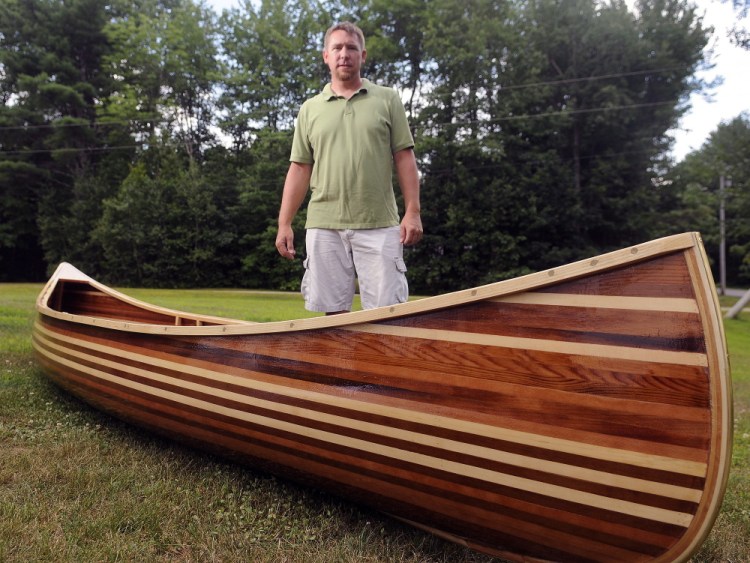Jeromy Jamison has heard the question a lot during his nearly 20 years of teaching mathematics. How, Jamison’s students wonder, will they ever use in real life the equations and theorems they are being asked to learn?
Jamison understands the question because he’s been known to ask it himself.
“I hated abstract theory,” he said. “I remember being there, but luckily enough I grew up in a family where we were doing construction, building houses and stuff, so I learned how to apply the math.”
So when Jamison went in search for ways to help his Hall-Dale Middle and High School students apply what they were learning, he turned to what he knew: construction.
But instead of a house, Jamison and his students spent the last six months of school building a cedar strip canoe in his classroom in Farmingdale.
“It was interesting,” Jamison said. “The students learned a lot. I learned a lot.”
Jamison, who tracked down more than $2,600 in donations to be able to buy the kit, now is raffling off the fruit of all that labor, a gorgeous 15-foot canoe, with an eye toward funding a similar project next year. Jamison hopes he has found a model that will fund the project every year.
“We hope to make it perpetual,” Jamison said.
Hall-Dale, like many schools across the state, has no industrial arts program. It was cut in 1996 in an effort to trim the budget, Jamison said, so he started from scratch. He began by seeking permission from former Superintendent Virgil Hammonds, who approved the project as long as it involved no power tools beyond a cordless drill. The stipulation made building a cedar strip canoe, which mostly requires just hammers, glue and a fastidious attention to detail, the perfect project. Principal Mark Tinkham, who once worked at Cape Elizabeth High School, which has is a boat-building program, also signed off on the project.
“They were both very supportive,” Jamison said.
Jamison turned to the community to raise the money to buy the kit from Canadian-based Bear Mountain Boats. Mark Guyan got things rolling one night as he and Jamison stood on the sidelines, watching their sons play soccer.
“He said he heard we wanted to build a canoe in class,” Jamison recalled. “He said, ‘I’ll send you a check for $100 tomorrow. I’ll get you started.”
Jamison mailed out fundraising letters. He found no shortage of people willing to help. The list of donors included a healthy helping of locally owned businesses.
“All those companies were really great,” Jamison said.
The project got underway in December with construction of the strongback, which holds the forms that give shape to the strips of cedar. Along the way, Jamison and the students even built a steamer for bending the oak and ash stems. Student Cam Corbin steamed the wood in a steam-box fueled by a teakettle.
“He just took them like butter and bent them around,” Jamison said. “It was amazing. I’ve never seen anything like that before.”
The canoe slowly began taking shape as Jamison and the students worked on it over the next several months. Any high school or middle school student could work on the project during study hall or break and during Jamison’s math class once their book work was complete. About 20 students have a hand in the canoe, he said. Some of them put in as much 15 hours. The entire project took about 180 hours.
“It all adds up,” Jamison said.
From the very first steps, as students had to read the blueprints and convert them into reality, the project did all Jamison hoped it would. Before they knew it, the students regularly were using the mathematics they had believed was ultimately pointless. One of those students happened to be Jamison’s own son.
“He said, ‘Dad, I see all this high-end math, but it makes no sense until I apply it,'” Jamison said. “We were talking about parallel lines and Pythagoras and things like that, and he says, ‘Well, there it is.’ It made sense.”
The project took the students into realms beyond mathematics and construction, however. High school art teacher Jen Paisley, who sails professionally with her husband, provided expertise in selecting the pattern for the canoe and the chemical mixtures for applying the fiberglass and epoxy resin.
High school chemistry teacher Jeff Cleaveland talked about his time building cedar strip kayaks in Washington.
The students read books on building canoes, including “Canoecraft,” by Ted Moores, which they immediately applied to their project.
“We were getting real-life learning,” Jamison said.
Jamison is raffling off 130 tickets at $20 each to pay for next year’s canoe. The raffle will be held once all the tickets have sold, and Jamison said he is more than halfway there. Jamison took the canoe to the recent Old Hallowell Day celebration, where the canoe itself helped sell a fair number of tickets.
“Some of the students who worked on it came in and were like, ‘Hey Mom and Dad, that’s the canoe I built!’ which is great,” Jamison said.
Some of the older men who have built their own canoes over the years dropped by to offer their own assessment and advice.
“This year was sort of the let’s-get-our-feet-wet learning curve and see how steep it is,” Jamison said. “Next year there will be a lot more work the kids can do.”
For information on the project, or to purchase a raffle ticket, visit online or email Jamison at JJamison@halldale.org.
Craig Crosby — 621-5642
Twitter: @CraigCrosby4
Send questions/comments to the editors.



